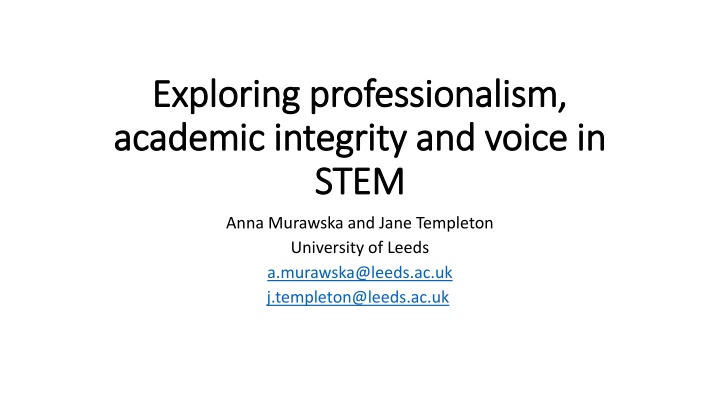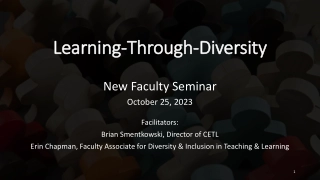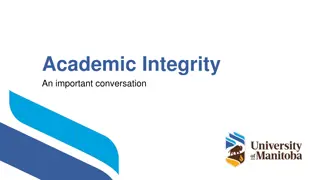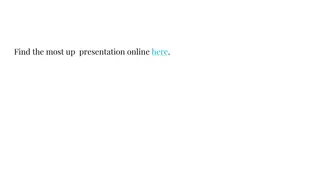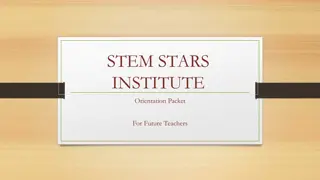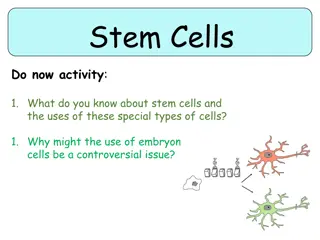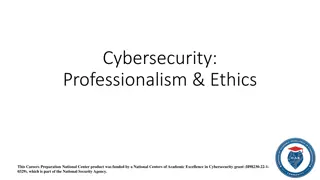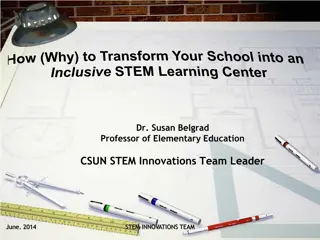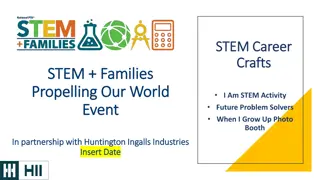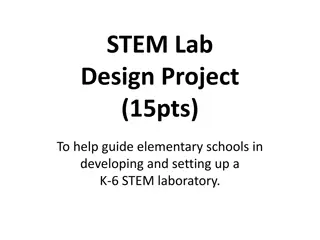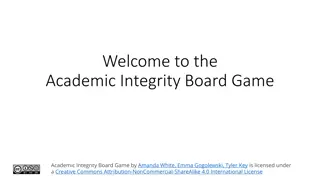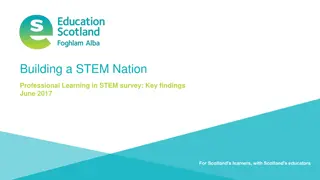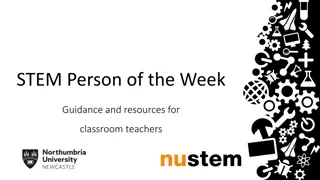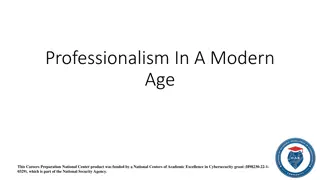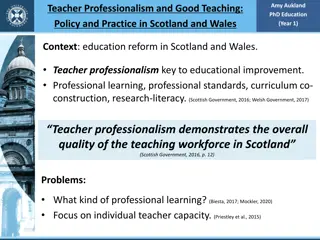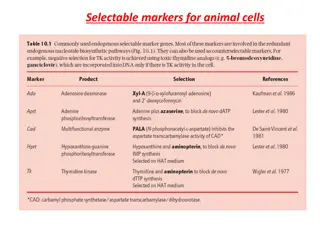Professionalism and Academic Integrity in STEM Education
Delve into the nuances of professionalism and academic integrity within STEM education, exploring challenges faced by students and educators alike. Gain insights from case studies and reflections, shedding light on ethical boundaries and the need for a strong sense of responsibility in the academic and professional spheres.
Download Presentation

Please find below an Image/Link to download the presentation.
The content on the website is provided AS IS for your information and personal use only. It may not be sold, licensed, or shared on other websites without obtaining consent from the author.If you encounter any issues during the download, it is possible that the publisher has removed the file from their server.
You are allowed to download the files provided on this website for personal or commercial use, subject to the condition that they are used lawfully. All files are the property of their respective owners.
The content on the website is provided AS IS for your information and personal use only. It may not be sold, licensed, or shared on other websites without obtaining consent from the author.
E N D
Presentation Transcript
Exploring professionalism, Exploring professionalism, academic integrity and voice in academic integrity and voice in STEM STEM Anna Murawska and Jane Templeton University of Leeds a.murawska@leeds.ac.uk j.templeton@leeds.ac.uk
Overview 3 explorations 1. How AI in our context differs from our EAP understanding Anna: four nano case studies followed by lessons learnt & implications 2. How professionalism may be a useful lens through which to explore AI in Engineering Jane: discussion of models of engineering thinking 3. Your experiences and ideas
Case 2: We wouldnt expect engineers to cite Case 1: Technical definitions Case 3: What s the point? Case 4: Sharing code Medical engineering Summative portfolio: Tissue-specific research portfolio Submission 1: ppt slides with definitions / tissue description (shoulder ligament) Marker s feedback: I have used the TurnItIn report as the similarity score was 35%. For the final version it is very important that all of the text you submit is your own words and your own work Reflection: unsure what to advise. How to paraphrase definitions of technical terms? Language for Engineering (pre-sessional) Formative literature review. Marker s feedback: academic malpractice. Sources acknowledged but used verbatim. Student s response: Why do I have to change the words if I provided a citation? Reflection: student understands the currency of referring to sources, but does not see the point of paraphrasing Mechatronic and robotics Task: summative programming task Student: I worked really hard on this code and it solves real life problems so I uploaded it onto a website so everyone can download it and use it Reflection: It sounds noble, and exactly what a professional programmer would do, but is this allowed? Is it my place to comment on it? Advanced Mechanical Engineering Summative open book exam. Example questions: Describe and explain two different ways in which Design 1 might be problematic. Consider the principles of display design. Marker s feedback: we don t need to see a reference but explanation in students own words Reflection: at odds with hierarchy of academic malpractice in our department (plagiarism vs malpractice)
Lessons & implications: students AI guidelines perceived as arbitrary, tasks as academic pursuit explicit exploration of professional standards seems more meaningful Perhaps researchers should be exploring how STEM students can be encouraged to view themselves as budding professionals who feel a sense of responsibility to strong internal values, colleagues and mentors, their field of study, and society. (Gilmore et al., 2016: 742) responsibility to colleagues and the public more prominent in engineering code of conduct than in institutional definitions (Pimple, 2002; Gilmore et al., 2016) Students unprepared to deal with actual AI dilemmas pre-sessional provision should better reflect the reality of future courses Critical look at AI materials in STEM EAP: e.g. In your academic work, you should refer to the work of others to support the points that you make Interventions that educate students to negotiate ethical boundaries between collaborative laboratory participation and the production of individually submitted work (e.g., the completion of a lab report ) are sorely needed. (Gilmore et al., 2016: 742)
Lessons & implications: tutors Support needed for EAP practitioners transitioning to STEM Research and collaboration with receiving departments needed STEM fields grouped together though field-specific academic integrity issues likely to exist; technology, maths hardly studied (Gilmore et al., 2016) Discipline specific education about AI as part of discipline enculturation (Bretag, 2016) Subject lecturers AI literacy Assessment literacy/design tasks/questions conducive to malpractice Building relationships & encouraging conversations to support lecturers & to inform EAP provision
Exploration 2: professionalism as useful lens? Key challenges for EAP teachers helping students develop AI literacy: Significant differences in understanding of AI between EAP and STEM Inconsistency across tasks and tutors no (explicit) common understanding Solution: making explicit links between academic literacies and professional attributes, contexts and standards (Gilmore, 2016, p.49) - students as "budding professionals" Links between assessment tasks and professionalism Curriculum informed by professional bodies -> tasks should resemble professional outputs/processes Framing core literacies in professional terms = effective in helping understanding Links between AI, voice and understanding of assessment tasks If we can help students avoid AI issues by helping them understand their tasks & find appropriate voice And we can help students understand their tasks by linking to professional contexts Then could professionalism be a useful lens for approaching AI, and EAP in STEM in general?
Thinking like an engineer Graduate attributes (University of Leeds, 2021) Communication skills Team Working Leadership Creative Problem Solving Commercial Awareness Flexibility Initiative Planning & Organisation Analytical Skills Research Skills Critical Thinking Independent Working Time Management Engineering habits of mind (Lucas et al., 2014, p.29)
A Critical Thinking Model for Engineers Fundamental elements of thinking (Paul et al., 2006, p.9) Whenever we think, we think for a purpose, within a point of view, based on assumptions, leading to implications and consequences. To answer a question or solve a problem, we use data, facts and experiences to make inferences and judgements based on concepts and theories. Important questions implied by these structures: What is my fundamental purpose? What is my point of view with respect to the issue? What assumptions am I using in my reasoning? What are the implications of my reasoning (if I am correct)? What is the key question I am trying to answer? What information do I need to answer my question? What are my most fundamental inferences and conclusions? What is the most basic concept in the question? (Niewoehner, 2006, p.3, adapted from Paul et al., 2006)
Intellectual traits / virtues Trait Intellectual integrity Intellectual empathy Confidence in reason What it means = holding yourself to the same intellectual standards you expect others to honor (no double standards). = accurately reconstructing the viewpoints and reasoning of our opponents and to reason from premises, assumptions, and ideas other than our own. Do I listen and seek to understand others' reasoning? Do I accurately represent viewpoints with which I disagree? Do I accurately represent oppone nts' views? would they agree? Do I recognize and appreciate insi ghts in the technical views of others and prejudices in my own? = using standards of reasonability as the fundamental criteria by which to judge whether to accept or reject any proposition or position. Questions to foster it To what extent do I expect of myself what I expect of others? To what extent are there contradictions or incons istencies in the way I deal with technical issues? To what extent do I strive to recognize and eliminate self- deception or self- interest when reasoning through engineering issues? Am I willing to change my position when the evidence leads to a more reasonable position? Do I adhere to technical principles and evidence when persuading others of my position or do I distort matters to support my position? Do I encourage others to come to their own technical conclusions or do I try to coerce agreement? (Niewoehner, 2006, pp. 3-5)
Reflections Conversations required need to be two-way. EAP teachers and students have a lot to contribute to collective understanding of AI Culture change possibly required away from conceptualisations of student deficit & AI as done-not-learned to these conversations Professionalism as useful basis for approaching conversations?
Exploration 3 - over to you! What critical incidents / surprises / "Oh? Ah!" moments have you had about AI? (in STEM or other disciplines) What resources have you found useful in exploring AI in STEM? What are your thoughts on using professional attributes as a basis for exploring core literacies? Padlet: https://padlet.com/amurawska/w26hdawkblmlyz4s
References Bretag, T. (2016). Discipline-specific approaches to academic integrity: Introduction. Handbook of Academic Integrity, 1st ed.; Bretag, T., Ed, 673-675. Gilmore, J., Maher, M., & Feldon, D. (2016). Prevalence, prevention, and pedagogical techniques: Academic integrity and ethical professional practice among STEM students. Handbook of academic integrity, 729-748. Lucas, B., Hanson, J., and Claxton, G. (2014). Thinking like an Engineer. [Online]. Royal Academy of Engineering. [Accessed 18 July 2021]. Available from https://www.raeng.org.uk/publications/reports/thinking-like-an-engineer-implications-full-report Niewoehner, R. J. (2006). A Critical Thinking Model for Engineering. 2nd International CDIO Conference, 13-14 June 2006, Linkoping, Sweden. [Online]. [Accessed 8 September 2020]. Available from http://wvvw.cdio.org/files/document/file/Niewoehner.pdf Paul, R., Niewoehner, R. J., and Elder, L. (2006). The Thinker s Guide to Engineering Reasoning. Sonoma, CA: Foundation for Critical Thinking. Pimple, K. D. (2002). Six domains of research ethics: A heuristic framework for the responsible conduct of research. Science and Engineering Ethics, 8, 191 205. University of Leeds. (2021). Graduate Attributes. Leeds for Life. [Online]. [Accessed 16 November 2021]. Available from https://classicleedsforlife.leeds.ac.uk/skills.aspx
